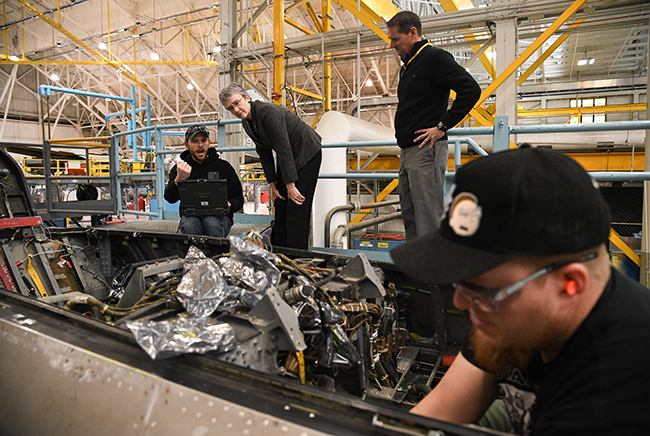
Cameron Weaver, 309th Aircraft Maintenance Group sheet metal mechanic, briefs Air Force Secretary Heather Wilson about F-16 depot maintenance during a base visit, Jan. 23, 2019, at Hill AFB, Utah. Air Force photo by R. Nial Bradshaw.
The Air Force’s three depots are plagued with expired equipment and have shown steadily decreasing on-time performance, prompting two of them to be listed in overall “poor” condition, the Government Accountability Office states in a new report.
The GAO evaluated all of the military’s service depots, including the Air Force’s Ogden Air Logistics Complex, Utah; Oklahoma City Air Logistics Complex, Okla.; and the Warner Robins Air Logistics Complex, Ga. The ratings, largely focused on the age of equipment and overall health of the facilities.
Ogden, which performs depot maintenance on key fighter aircraft at a time when the service is working to increase readiness of these fleets, received the worst overall rating in the report. While no military depot was rated as “failing,” the average condition of the depots is “poor.”
While the Air Force has said parts shortages at depots are a key reason for a drop in fighter readiness, the GAO report identifies the health of the depots themselves as an issue the services need to address.
“Our analysis of service metrics shows that depot facilities are, on average, rated as ‘poor’ on DOD’s facility rating scale, and the age of equipment at the depots generally exceeds its expected useful life,” the report states. “Meanwhile, performance at the service depots has generally declined since fiscal year 2007. Our previous work has shown that facility and equipment condition can affect depot performance. However, the military services do not consistently track the extent to which the condition of facilities and equipment affect depot performance.”
At Ogden, schedule performance has generally decreased over the past 11 years—down 20 percent from 2007 to 2017. While there was only data from fiscal 2018 to show the status of the complex’s facilities, in general it was rated to be “poor” and average equipment exceeded its service life by 12 years, the report states. In addition, repair requests have increased since 2009. As of 2017, Ogden had a backlog of about $259 million in restoration and modernization projects.
At Oklahoma City, schedule performance has remained stable, though the 2018 data of the facilities show them to be in a “poor” state. The complex’s equipment exceeds its useful life by an average of nine years, the report states. As of 2017, there was about $104 million in backlogged restoration projects.
At Warner Robins, the schedule performance has decreased 30 percent over the past 11 years. The 2018 data of the facilities show them to be in a “fair” state, though equipment is exceeding its useful life by 13 years, the report states. As of 2017, there was a backlog of about $190 million in restoration and modernization projects.
While the Air Force, along with the other services, have begun to develop plans to improve the depots, the GAO states these plans lack analytically based goals, results-oriented metrics, identification of required resources, and adequate reporting on progress. The GAO recommended the Air Force address these shortfalls, and the Pentagon agreed to those recommendations. However, the Defense Department said it needs to wait until these plans are completed before it can develop an approach to manage and program future investments.